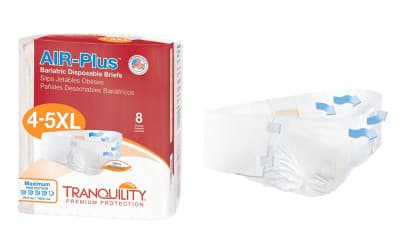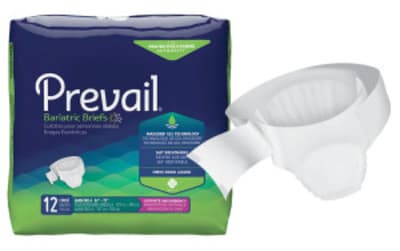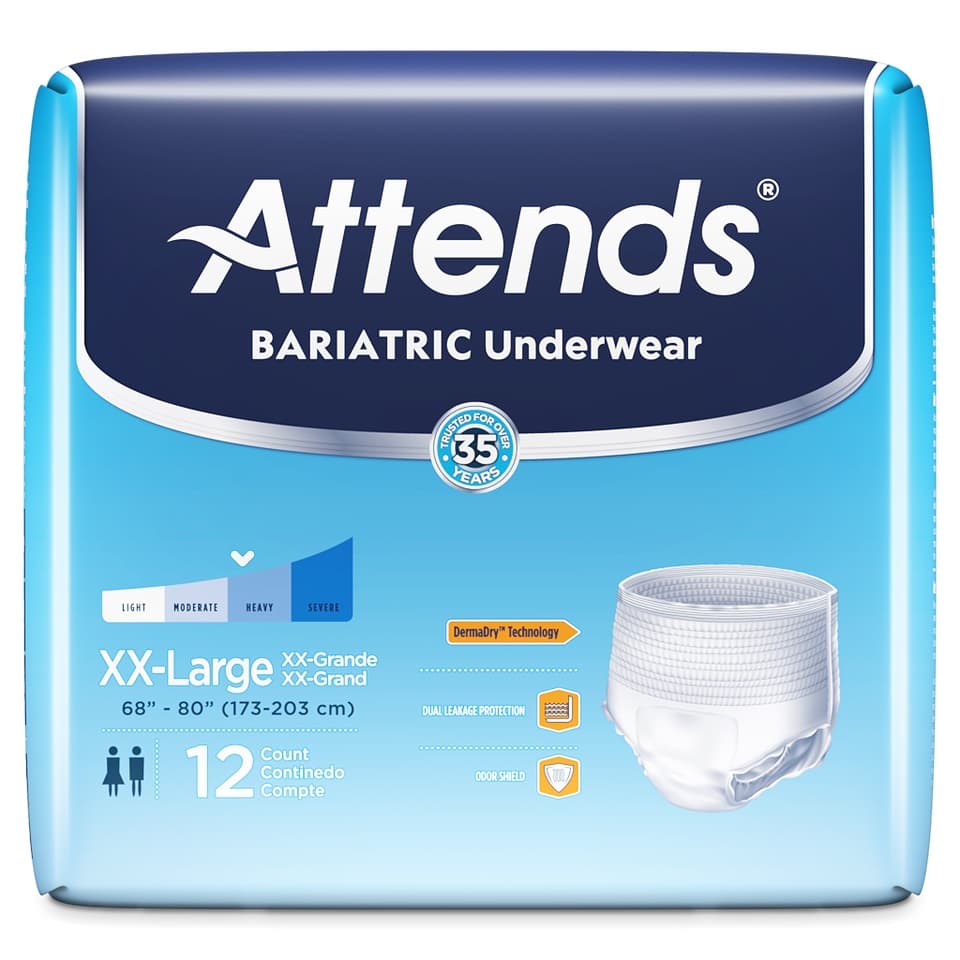Finding a diaper brand that provides you with just the right fit isn’t always a straightforward task. Browse our guide to the best ways to choose bariatric diapers and learn about the comfiest, most secure options you can buy online.
Key takeaways:
Adult bariatric diapers with tabs (also called plus-size briefs) are the ideal choice for anyone who needs a larger fit than traditional diapers or pull-up underwear.
Modern brands such as Tranquility offer in waist sizes up to 106 inches.
Other popular options include the and, which provide waist sizes from 62-100 inches.
Are you looking for a clear, easy-to-read guide on bariatric diapers? You’ve come to the right place! Whether you or a loved one needs a larger-sized diaper, we want to make sure we equip you with the most essential information.
What is a Bariatric Diaper?
Bariatric diapers (or “plus-sized diapers”) are absorbent with a thick core. They feature two side-tabs that fasten comfortably across the hips and over the belly. Larger than other incontinence underwear, bariatric diapers can accommodate waist sizes between 62 and 106 inches.
All diapers protect against urinary incontinence, and some work for bowel incontinence, too.

Bariatric incontinence isn’t a condition in itself. Rather, incontinence is a problem that many adults experience, due to aging and many other factors.
However, it should be noted that people with larger waists are more at risk of stress incontinence.
This is because being overweight can place extra pressure on the bladder, which increases the chances of urine leaks after sneezing, coughing, or lifting heavy objects.
Skincare for plus-sized patients can be an issue, too. For example, trying to fit into an incontinence pad or underwear that is too small can lead to chafing, rashes, and even skin infections.
Demand for bariatric diapers and underwear has risen in recent years. Partly, to ensure that incontinence protection is available for everyone, no matter their body shape. The other factor driving demand is the increase in obesity around the world.
In the United States, obesity among the population has risen from 30.5% in the year 2000 to 42.4% in 2018. Severe obesity has also become more common, nearly doubling from 4.7% to 9.2%.
Who Should Use Bariatric Diapers?
Penn Medicine defines this well. They say that: “A person may be referred to as a bariatric patient when they have a body mass index (BMI) that is equal to or greater than 30. BMI is used to measure weight in relation to height.”
Bariatric diapers are — first and foremost — a plus-sized product. If you are plus-sized, bariatric diapers with tabs are probably a good choice in the event that:
You have a caregiver that can help you with changes (if you don’t have a caregiver, it is tricky to put these on alone, but not impossible)
You or the person you’re caring for has low mobility or is bed-bound
You or your loved one has heavy voids or needs protection from bowel incontinence
You or a loved one experiences pinching from diapers that are too tight

Features:
Unisex, maximum absorbency
2XL to 3XL, 62-100 inch waist size
Easy-lock fasteners to get the perfect fit
Quick Wick design pulls incontinence into the core, away from the skin
SHOP NOW
Bariatric diapers with tabs may not be the best choice if:
You are looking for something discreet and thin – try bariatric pull-up underwear instead

Features:
Unisex, moderate absorbency
2XL, 68-80 inch waist size
“Confidence Cuff Protection” secure around the legs, keeping incontinence inside
Cloth-like backing provides a soft, elastic stretch
SHOP NOW
How Do Bariatric Diapers Work?
Simply put, bariatric diapers wrap around your belly, hips, and crotch area like large underwear. When you or your loved one leaks waste, the diaper traps it inside the absorbent core.
Polymers (tiny absorbent beads) help to soak up any moisture and turn it into a gel so that the skin stays dry.
Specifically created with plus-sized users in mind, bariatric diapers have different features that may help to make the fit feel more comfortable for your loved ones.
For a start, the sides of the diapers are more stretchy and breathable, keeping your loved one comfortable for longer periods of time.
Breathability is a key factor to pay attention to, as the skin of larger-sized patients and loved ones is more prone to folding. In such cases, excess moisture can lead to bacteria growth and infections, which you definitely don’t want!
To avoid this problem, bariatric diapers have small pores that enable heat and incontinence vapors to escape. This feature not only keeps your loved ones cool and comfortable, but also creates a dry, healthy environment for their skin.
How to Put Bariatric Diapers on Yourself
Most users find that putting on a plus-sized diaper is an easy process.
Here are the steps to follow:
Start by loosely attaching the tabs to the brief, creating the shape of underwear
Step into the diaper and pull it over your body, just like you would with regular underwear
Adjust the straps, one at a time, until the fit is just right
The simplest way to put a bariatric diaper on someone else is to start with them in a lying-down position. Once they’re in a comfortable position, you can do the following:
Fold the brief lengthwise with the back sheet turned outwards
Roll the person you’re caring for onto their side, then pull the brief between the legs
Open the backside of the brief so that it fully covers the buttocks
Roll the wearer onto their back, then fan out the front panel (like you did with the back panel)
If there’s one tab…
Start with one of the side tabs. Stretch it over the hips and across the belly, snugly fastening it to the front of the diaper
Repeat the above step with the other tab
If there are two tabs...
Start with the bottom tab on one side of the diaper. Pull across the hips and fasten against the diaper, then repeat the same step on the other side
On one side, form a small fold in the band of the diaper, then attach the top tape over the fold, angling downward
Repeat the above step with the other side
Make sure the backsheet is turned away from the skin, and the core of the diaper is completely unfolded
Other Factors to Consider
Refastenable Tabs
Bariatric diapers with tabs either feature tabs that stick once or refastenable tabs.
Refastenable tabs can be pulled off the diaper and refastened as many times as you need without losing stickiness. This way, you ensure you get the perfect fit.
Sturdiness of Tabs
“Strong tabs” or “study tabs” mean that they’re less likely to rip, so you can feel more confident.
Typically, they’re also a little more comfortable.
Stretchy Sides
“Stretchy sides” or “stretchy tabs” are easier to stretch across the hips and tend to be more comfortable.
Amount of Tabs
Some bariatric diapers have two tabs (one on each side) and some have four (two on each side).
Which style works best for you will be a matter of personal preference. But, in general, two-tab styles are easier to put on, while four-tab styles are sturdier.
Leg Gathers
Some bariatric diapers will have “leg gathers,” also called “leg guards.”
These are pieces of fabric that run along the leg holes and catch leaks before they spill out.
High-Rise Fits
Certain bariatric diapers include a “high-rise fit.”
This means that they have a longer front and back panel, so they can more thoroughly cover the back and belly.
Backing Material
Most of the bariatric diapers on the Carewell store have cloth-like outer backing, meaning they’re quiet, breathable, and better for your skin. Avoid diapers that have a plastic backing, as these can trap harmful vapors from incontinence and damage skin.
Odor Control
For those who want to feel fresh and clean at all times, search for plus-sized diapers that feature odor control technology — such as these McKesson Bariatric Ultra Briefs with Tabs.
Wetness Indicators
Like with the cloth-like backing, most of our bariatric diapers come with wetness indicators.
While each diaper looks slightly different, the diapers with wetness indicators have a color-changing marker to indicate when it’s full. This makes for a hassle-free way to know when it’s time to change.
How Do I Choose the Right Bariatric Diaper for Me?
Really, there are three main steps to consider in the decision-making process:
Think about which features are the most important to you. If the diapers are for someone else, talk to them about it, if possible. Which diapers did they use in the past? And what did they like or dislike about them?
Figure out what level of absorbency you need. If the wearer has bowel incontinence or heavier accidents, you’ll be best served opting for a higher absorbency level
Measure the waist and hips of whoever will be wearing the diaper, whether it's you or a loved one. Use whichever of those two numbers are larger to reference our sizing guides
Pro-tips:
Having a plus-sized pants size does not mean you need plus-sized diapers. To make sure you get the right size, measure both your waist and hip sizes in inches, then use the larger of the two numbers to reference the sizing guides we provide with each product.
Shopping around for the best bariatric diapers can be confusing, at first, but it needn’t be.
A sensible approach is to ask yourself:
"Why do I need a bariatric product?"
"How much incontinence protection do I need?"
and finally,
"Which bariatric diaper should I choose?"
Bariatric diapers with side tabs are a great choice for many, but they’re not the only ones that exist. Here are four of the most “in-demand” options that get positive reviews from customers:
Different types of incontinence protection are designed for different parts of the day. You can order day-use underwear, as well as overnight diapers.
"Overnight" diapers are usually more absorbent. They can last longer without changing but are bulkier to wear.
Day-use bariatric pull-up underwear are labeled according to their absorbent capacity. The absorbency ranges from light to moderate to heavy. They are less bulky, making them a useful go-to for still being able to carry on with your everyday activities, discreetly.
If you’re concerned that your diapers are not absorbent enough, don’t worry —other options can be used along with the diaper. Booster pads do what their name suggests—they boost absorbency, and can be placed inside the diaper for extra protection and comfort.
Tranquility TopLiner Booster Pads - increase the absorbency of any protective underwear or tab-style diaper
Additional items, such as moisture-proof backsheets (or underpads), provide further protection.
These underpads can be secured to bedding, furniture, or wheelchairs for extra absorbency.
Tranquility Peach Sheet Underpads, Maximum - absorbent core holds over one quart of liquid
Luckily, our bariatric diapers are super absorbent and many caregivers won’t need any companion products. That being said, there are a number of products that can better support your loved one’s skin health, comfort, and that can even reduce odors.
Gloves
Gloves are a caregivers’ best friend! When changing your loved one’s bariatric diapers, it’s important to keep hands clean and safe from incontinence. Gloves provide a gentle barrier, protecting your skin and theirs.
Wipes
Adult hygienic wipes are double the size of baby wipes, pre-moistened, and come in skin-sensitive varieties. Typically used at each diaper change, adult wipes keep your loved one clean and protect from incontinence-related skin concerns.
Cleansers & Creams
Barrier creams and diaper creams protect your loved one’s most delicate skin from moisture, preserving integrity and preventing rashes, ulcers and sores. Perineal washes and cleaners are ideal for a deeper clean, for those that want to feel extra fresh or what are experiencing bowel incontinence and want a heavy-duty clean.
Deodorizing spray
Many of our bariatric diapers with tabs come with a built-in odor guard. That being said, deodorizing sprays can provide an extra layer of protection in your home when you need it most.
Thanks for reading!
We hope you’ve found this guide on bariatric diapers useful.
If you need additional help choosing the right kind of bariatric incontinence protection, call the Carewell support team at (800) 696-CARE or contact us at support@carewell.com.
SUGGESTED READ: Bariatric Care Tips for Caregivers






